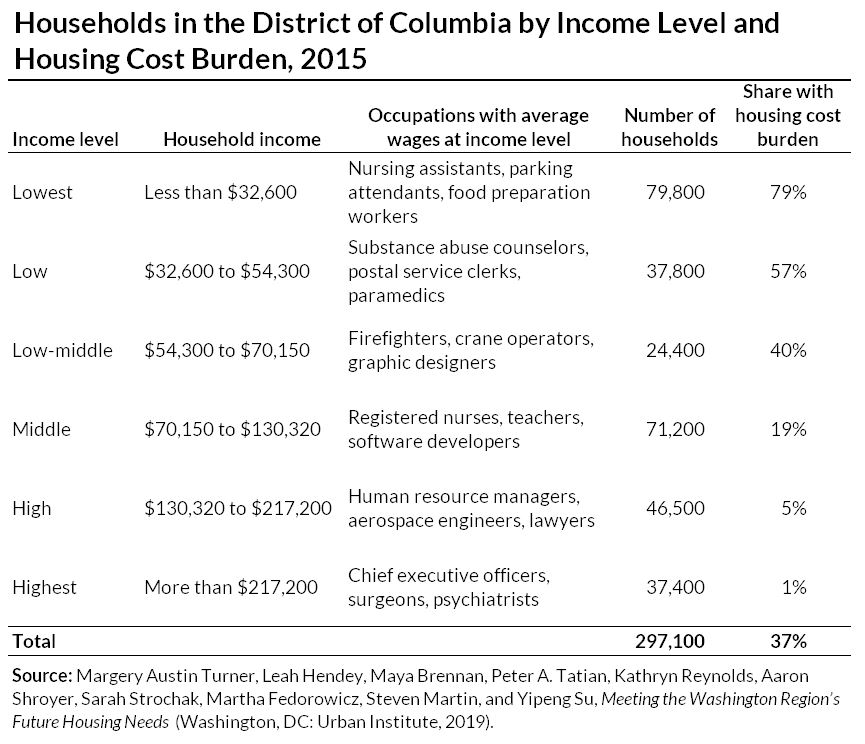
In its new Housing Equity Report (PDF), the District of Columbia sets ambitious targets for expanding housing affordability in every part of the city. Earlier this year, Mayor Bowser directed city agencies to identify new policies, tools, and initiatives to create 36,000 new housing units—12,000 of them affordable for people with low incomes—by 2025. The Metropolitan Washington Council of Governments has called upon all the other jurisdictions in our region to follow suit, setting targets for both housing production and affordability.
The Housing Equity Report takes an important next step: showing where the city will support additional housing that is affordable for people with low incomes.
It sets a long-term goal of making at least 15 percent of the housing in every DC Planning Area affordable by 2050. Areas falling short today are allocated more affordable housing between now and 2025. Areas that already exceed the 15 percent goal are allocated less.
Plenty of questions remain about how to achieve these targets. But solid evidence supports the city’s strategy. Over the past decade, housing production hasn’t been keeping up with population growth, and rents and house prices have climbed out of reach for too many city residents. And today, the number of DC households with low incomes far exceeds the number of housing units they can reasonably afford. Four of every five households with the lowest incomes—including many working full-time in jobs like caregiving or food preparation—pay more than 30 percent of their income for housing.

Affordable housing matters for DC’s future
A stable home that doesn’t bust the family budget provides a foundation for adults’ economic advancement and for children’s healthy development. Employers need a diversity of talent to fill all their positions, and attracting, developing, and retaining such a workforce depends on the availability of housing that people of all household types and incomes can afford. Affordable housing close to jobs boosts workers’ reliability. And vibrant neighborhoods with plenty of housing options attract new business and residents, fueling continued growth and prosperity.
Historically, DC—like most US cities—has clustered its most affordable housing in just a few neighborhoods. Longstanding fears and prejudice have blocked families with low incomes and people of color from communities that offer safety, great schools, a healthy environment, and access to jobs.
For example, zoning policies like large lot-size requirements and large square-footage-per-dwelling mandates increase the cost of housing in exclusive neighborhoods. And both federal and local housing programs long prioritized building subsidized housing in already distressed neighborhoods.
At the same time, many neighborhoods where housing is more affordable have been starved of capital by both public- and private-sector institutions, leaving them with troubled schools, inadequate services, physical and environmental blight, and high levels of crime and violence.
Rigorous research leaves no doubt that separate and unequal neighborhoods undermine the life chances of children and, hence, the city’s commitment to shared prosperity. Remedies must include more affordable housing in opportunity-rich neighborhoods alongside investments in distressed neighborhoods so they become springboards to opportunity for their residents
DC’s plan steps up to the national challenge of “affirmatively furthering fair housing,” committing to expanding low-cost housing in parts of the city that have excluded it in the past.
Our recent report, Meeting the Washington Region’s Future Housing Needs, urges local leaders to set goals for meeting the needs of current and future residents. And it offers a menu of policies they can use to preserve existing homes and apartments that people with low incomes can afford; produce enough new housing to keep pace with growth; and protect renters and homeowners from discrimination and involuntary displacement.
DC has enjoyed tremendous prosperity and growth over the past two decades. Expanding affordable housing in every part of the city can help ensure that prosperity is widely shared.
Let’s build a future where everyone, everywhere has the opportunity and power to thrive
Urban is more determined than ever to partner with changemakers to unlock opportunities that give people across the country a fair shot at reaching their fullest potential. Invest in Urban to power this type of work.